Qipeng Guo
Eric
How to Set the Learning Rate for Large-Scale Pre-training?
Jan 08, 2026Abstract:Optimal configuration of the learning rate (LR) is a fundamental yet formidable challenge in large-scale pre-training. Given the stringent trade-off between training costs and model performance, the pivotal question is whether the optimal LR can be accurately extrapolated from low-cost experiments. In this paper, we formalize this investigation into two distinct research paradigms: Fitting and Transfer. Within the Fitting Paradigm, we innovatively introduce a Scaling Law for search factor, effectively reducing the search complexity from O(n^3) to O(n*C_D*C_η) via predictive modeling. Within the Transfer Paradigm, we extend the principles of $μ$Transfer to the Mixture of Experts (MoE) architecture, broadening its applicability to encompass model depth, weight decay, and token horizons. By pushing the boundaries of existing hyperparameter research in terms of scale, we conduct a comprehensive comparison between these two paradigms. Our empirical results challenge the scalability of the widely adopted $μ$ Transfer in large-scale pre-training scenarios. Furthermore, we provide a rigorous analysis through the dual lenses of training stability and feature learning to elucidate the underlying reasons why module-wise parameter tuning underperforms in large-scale settings. This work offers systematic practical guidelines and a fresh theoretical perspective for optimizing industrial-level pre-training.
Beyond Real: Imaginary Extension of Rotary Position Embeddings for Long-Context LLMs
Dec 08, 2025Abstract:Rotary Position Embeddings (RoPE) have become a standard for encoding sequence order in Large Language Models (LLMs) by applying rotations to query and key vectors in the complex plane. Standard implementations, however, utilize only the real component of the complex-valued dot product for attention score calculation. This simplification discards the imaginary component, which contains valuable phase information, leading to a potential loss of relational details crucial for modeling long-context dependencies. In this paper, we propose an extension that re-incorporates this discarded imaginary component. Our method leverages the full complex-valued representation to create a dual-component attention score. We theoretically and empirically demonstrate that this approach enhances the modeling of long-context dependencies by preserving more positional information. Furthermore, evaluations on a suite of long-context language modeling benchmarks show that our method consistently improves performance over the standard RoPE, with the benefits becoming more significant as context length increases. The code is available at https://github.com/OpenMOSS/rope_pp.
InternVL3.5: Advancing Open-Source Multimodal Models in Versatility, Reasoning, and Efficiency
Aug 25, 2025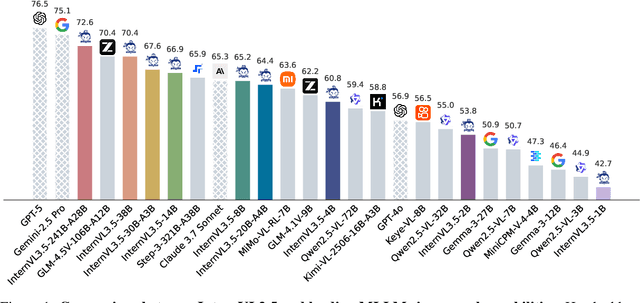
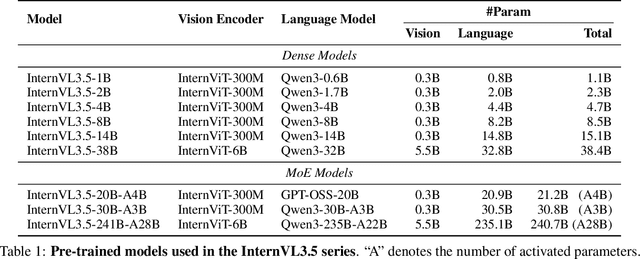

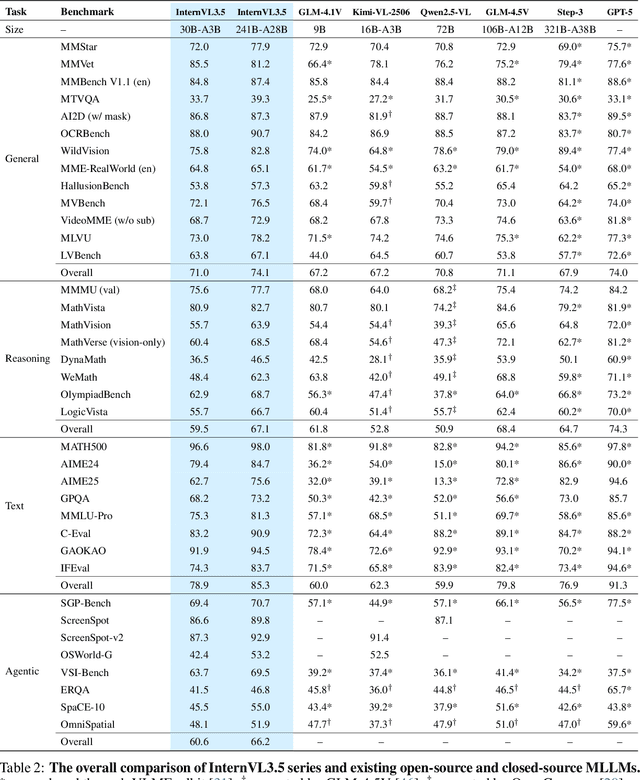
Abstract:We introduce InternVL 3.5, a new family of open-source multimodal models that significantly advances versatility, reasoning capability, and inference efficiency along the InternVL series. A key innovation is the Cascade Reinforcement Learning (Cascade RL) framework, which enhances reasoning through a two-stage process: offline RL for stable convergence and online RL for refined alignment. This coarse-to-fine training strategy leads to substantial improvements on downstream reasoning tasks, e.g., MMMU and MathVista. To optimize efficiency, we propose a Visual Resolution Router (ViR) that dynamically adjusts the resolution of visual tokens without compromising performance. Coupled with ViR, our Decoupled Vision-Language Deployment (DvD) strategy separates the vision encoder and language model across different GPUs, effectively balancing computational load. These contributions collectively enable InternVL3.5 to achieve up to a +16.0\% gain in overall reasoning performance and a 4.05$\times$ inference speedup compared to its predecessor, i.e., InternVL3. In addition, InternVL3.5 supports novel capabilities such as GUI interaction and embodied agency. Notably, our largest model, i.e., InternVL3.5-241B-A28B, attains state-of-the-art results among open-source MLLMs across general multimodal, reasoning, text, and agentic tasks -- narrowing the performance gap with leading commercial models like GPT-5. All models and code are publicly released.
InternBootcamp Technical Report: Boosting LLM Reasoning with Verifiable Task Scaling
Aug 12, 2025



Abstract:Large language models (LLMs) have revolutionized artificial intelligence by enabling complex reasoning capabilities. While recent advancements in reinforcement learning (RL) have primarily focused on domain-specific reasoning tasks (e.g., mathematics or code generation), real-world reasoning scenarios often require models to handle diverse and complex environments that narrow-domain benchmarks cannot fully capture. To address this gap, we present InternBootcamp, an open-source framework comprising 1000+ domain-diverse task environments specifically designed for LLM reasoning research. Our codebase offers two key functionalities: (1) automated generation of unlimited training/testing cases with configurable difficulty levels, and (2) integrated verification modules for objective response evaluation. These features make InternBootcamp fundamental infrastructure for RL-based model optimization, synthetic data generation, and model evaluation. Although manually developing such a framework with enormous task coverage is extremely cumbersome, we accelerate the development procedure through an automated agent workflow supplemented by manual validation protocols, which enables the task scope to expand rapidly. % With these bootcamps, we further establish Bootcamp-EVAL, an automatically generated benchmark for comprehensive performance assessment. Evaluation reveals that frontier models still underperform in many reasoning tasks, while training with InternBootcamp provides an effective way to significantly improve performance, leading to our 32B model that achieves state-of-the-art results on Bootcamp-EVAL and excels on other established benchmarks. In particular, we validate that consistent performance gains come from including more training tasks, namely \textbf{task scaling}, over two orders of magnitude, offering a promising route towards capable reasoning generalist.
IFDECORATOR: Wrapping Instruction Following Reinforcement Learning with Verifiable Rewards
Aug 06, 2025Abstract:Reinforcement Learning with Verifiable Rewards (RLVR) improves instruction following capabilities of large language models (LLMs), but suffers from training inefficiency due to inadequate difficulty assessment. Moreover, RLVR is prone to over-optimization, where LLMs exploit verification shortcuts without aligning to the actual intent of user instructions. We introduce Instruction Following Decorator (IFDecorator}, a framework that wraps RLVR training into a robust and sample-efficient pipeline. It consists of three components: (1) a cooperative-adversarial data flywheel that co-evolves instructions and hybrid verifications, generating progressively more challenging instruction-verification pairs; (2) IntentCheck, a bypass module enforcing intent alignment; and (3) trip wires, a diagnostic mechanism that detects reward hacking via trap instructions, which trigger and capture shortcut exploitation behaviors. Our Qwen2.5-32B-Instruct-IFDecorator achieves 87.43% accuracy on IFEval, outperforming larger proprietary models such as GPT-4o. Additionally, we demonstrate substantial improvements on FollowBench while preserving general capabilities. Our trip wires show significant reductions in reward hacking rates. We will release models, code, and data for future research.
LongLLaDA: Unlocking Long Context Capabilities in Diffusion LLMs
Jun 17, 2025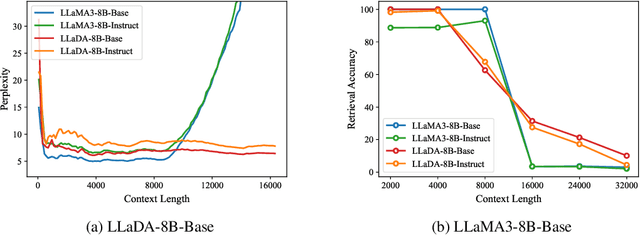

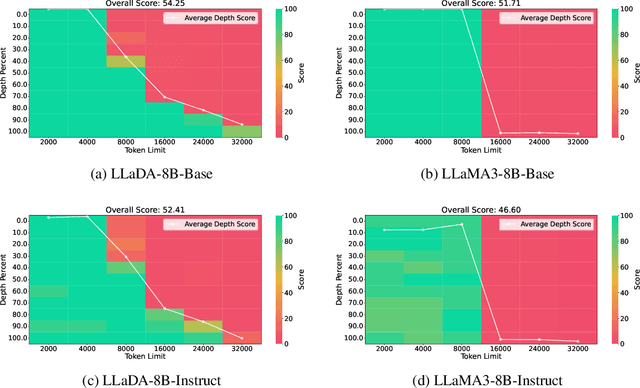

Abstract:Large Language Diffusion Models, or diffusion LLMs, have emerged as a significant focus in NLP research, with substantial effort directed toward understanding their scalability and downstream task performance. However, their long-context capabilities remain unexplored, lacking systematic analysis or methods for context extension. In this work, we present the first systematic investigation comparing the long-context performance of diffusion LLMs and traditional auto-regressive LLMs. We first identify a unique characteristic of diffusion LLMs, unlike auto-regressive LLMs, they maintain remarkably \textbf{\textit{stable perplexity}} during direct context extrapolation. Furthermore, where auto-regressive models fail outright during the Needle-In-A-Haystack task with context exceeding their pretrained length, we discover diffusion LLMs exhibit a distinct \textbf{\textit{local perception}} phenomenon, enabling successful retrieval from recent context segments. We explain both phenomena through the lens of Rotary Position Embedding (RoPE) scaling theory. Building on these observations, we propose LongLLaDA, a training-free method that integrates LLaDA with the NTK-based RoPE extrapolation. Our results validate that established extrapolation scaling laws remain effective for extending the context windows of diffusion LLMs. Furthermore, we identify long-context tasks where diffusion LLMs outperform auto-regressive LLMs and others where they fall short. Consequently, this study establishes the first context extrapolation method for diffusion LLMs while providing essential theoretical insights and empirical benchmarks critical for advancing future research on long-context diffusion LLMs.
Capability Salience Vector: Fine-grained Alignment of Loss and Capabilities for Downstream Task Scaling Law
Jun 16, 2025



Abstract:Scaling law builds the relationship between training computation and validation loss, enabling researchers to effectively predict the loss trending of models across different levels of computation. However, a gap still remains between validation loss and the model's downstream capabilities, making it untrivial to apply scaling law to direct performance prediction for downstream tasks. The loss typically represents a cumulative penalty for predicted tokens, which are implicitly considered to have equal importance. Nevertheless, our studies have shown evidence that when considering different training data distributions, we cannot directly model the relationship between downstream capability and computation or token loss. To bridge the gap between validation loss and downstream task capabilities, in this work, we introduce Capability Salience Vector, which decomposes the overall loss and assigns different importance weights to tokens to assess a specific meta-capability, aligning the validation loss with downstream task performance in terms of the model's capabilities. Experiments on various popular benchmarks demonstrate that our proposed Capability Salience Vector could significantly improve the predictability of language model performance on downstream tasks.
Beyond Homogeneous Attention: Memory-Efficient LLMs via Fourier-Approximated KV Cache
Jun 13, 2025Abstract:Large Language Models struggle with memory demands from the growing Key-Value (KV) cache as context lengths increase. Existing compression methods homogenize head dimensions or rely on attention-guided token pruning, often sacrificing accuracy or introducing computational overhead. We propose FourierAttention, a training-free framework that exploits the heterogeneous roles of transformer head dimensions: lower dimensions prioritize local context, while upper ones capture long-range dependencies. By projecting the long-context-insensitive dimensions onto orthogonal Fourier bases, FourierAttention approximates their temporal evolution with fixed-length spectral coefficients. Evaluations on LLaMA models show that FourierAttention achieves the best long-context accuracy on LongBench and Needle-In-A-Haystack (NIAH). Besides, a custom Triton kernel, FlashFourierAttention, is designed to optimize memory via streamlined read-write operations, enabling efficient deployment without performance compromise.
GeometryZero: Improving Geometry Solving for LLM with Group Contrastive Policy Optimization
Jun 08, 2025Abstract:Recent advances in large language models (LLMs) have demonstrated remarkable capabilities across diverse domains, particularly in mathematical reasoning, amid which geometry problem solving remains a challenging area where auxiliary construction plays a enssential role. Existing approaches either achieve suboptimal performance or rely on massive LLMs (e.g., GPT-4o), incurring massive computational costs. We posit that reinforcement learning with verifiable reward (e.g., GRPO) offers a promising direction for training smaller models that effectively combine auxiliary construction with robust geometric reasoning. However, directly applying GRPO to geometric reasoning presents fundamental limitations due to its dependence on unconditional rewards, which leads to indiscriminate and counterproductive auxiliary constructions. To address these challenges, we propose Group Contrastive Policy Optimization (GCPO), a novel reinforcement learning framework featuring two key innovations: (1) Group Contrastive Masking, which adaptively provides positive or negative reward signals for auxiliary construction based on contextual utility, and a (2) length reward that promotes longer reasoning chains. Building on GCPO, we develop GeometryZero, a family of affordable-size geometric reasoning models that judiciously determine when to employ auxiliary construction. Our extensive empirical evaluation across popular geometric benchmarks (Geometry3K, MathVista) demonstrates that GeometryZero models consistently outperform baselines (e.g. GRPO), achieving an average improvement of 4.29% across all benchmarks.
VisuoThink: Empowering LVLM Reasoning with Multimodal Tree Search
Apr 12, 2025Abstract:Recent advancements in Large Vision-Language Models have showcased remarkable capabilities. However, they often falter when confronted with complex reasoning tasks that humans typically address through visual aids and deliberate, step-by-step thinking. While existing methods have explored text-based slow thinking or rudimentary visual assistance, they fall short of capturing the intricate, interleaved nature of human visual-verbal reasoning processes. To overcome these limitations and inspired by the mechanisms of slow thinking in human cognition, we introduce VisuoThink, a novel framework that seamlessly integrates visuospatial and linguistic domains. VisuoThink facilitates multimodal slow thinking by enabling progressive visual-textual reasoning and incorporates test-time scaling through look-ahead tree search. Extensive experiments demonstrate that VisuoThink significantly enhances reasoning capabilities via inference-time scaling, even without fine-tuning, achieving state-of-the-art performance in tasks involving geometry and spatial reasoning.
 Add to Chrome
Add to Chrome Add to Firefox
Add to Firefox Add to Edge
Add to Edge